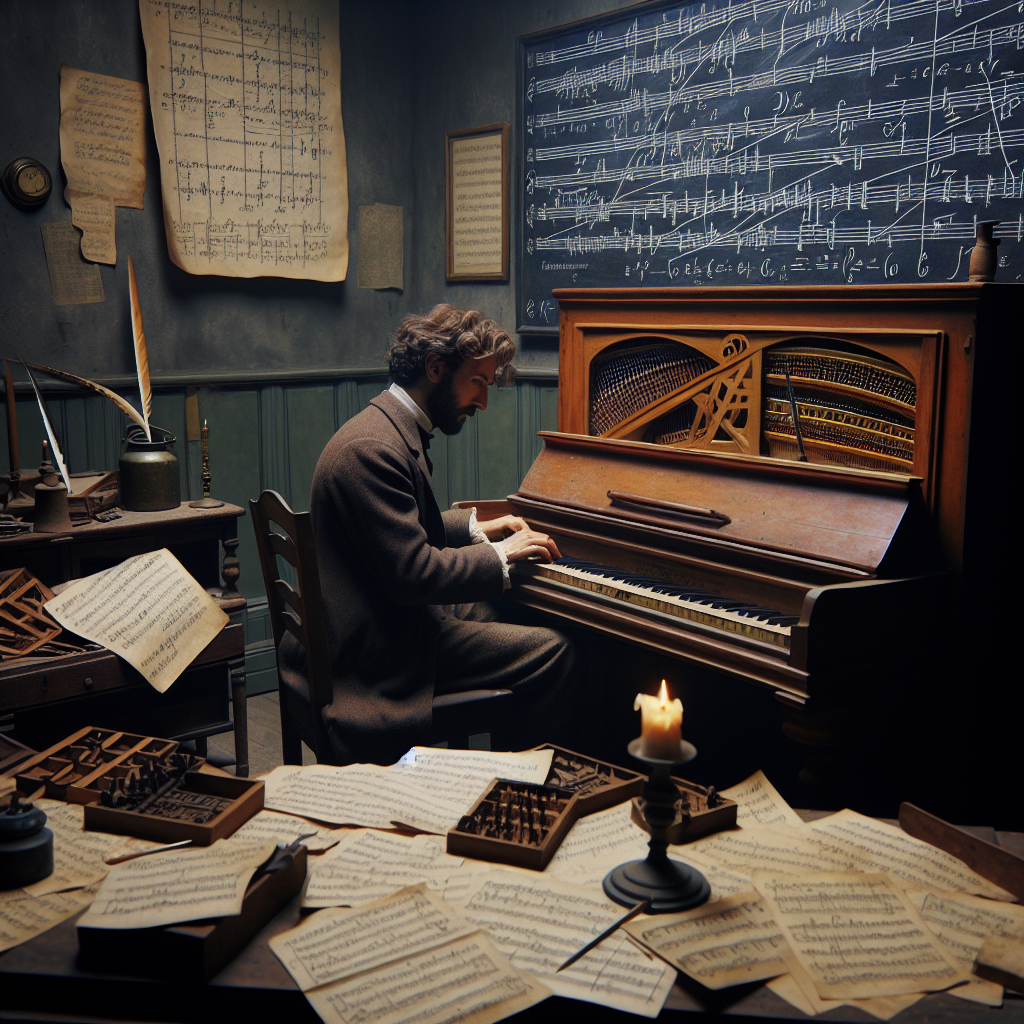
Beethoven’s Musical Experiments – Lost Works and Their Insights
Ludwig van Beethoven, one of the most influential figures in the history of Western music, is often celebrated for his groundbreaking compositions and his ability to translate his personal struggles into musical genius. However, before he became synonymous with masterpieces like the “Fifth Symphony” and the “Moonlight Sonata,” Beethoven was a young and unapologetically experimental musician. This article explores the early and unpublished works of Beethoven, illuminating how his lesser-known pieces pave the way for the genius we recognize today. These works serve as a fascinating glimpse into the developmental stages of Beethoven’s musical journey and give us valuable insights into his emerging style, creative process, and innovative spirit.
Born in Bonn, Germany, in 1770, Beethoven showed prodigious talent from an early age. Under the tutelage of Christian Gottlob Neefe, he published his first work at just 12 years old. Despite facing severe hearing loss later in life, Beethoven’s passion for music led him to Vienna, where he studied with the renowned Joseph Haydn. During his early years in Vienna, Beethoven was not just a performer; he was voraciously composing new works, many of which remain overshadowed by his later accomplishments. These early compositions, although not all recognized during his lifetime, provide a critical window into his evolution as a composer.
This in-depth exploration of Beethoven’s early and unpublished works reveals his musical experiments, risks, and gradual mastery. His willingness to venture into new realms, even with the knowledge that not every endeavor would be a resounding success, is evident in the diverse range of his early attempts. Through this, we understand the foundational elements that contribute to his subsequent iconic status.
Early Influences and First Compositions:
Beethoven’s musical abilities were recognized early by both his family and his mentor, Neefe. His initial compositions, including the “Dressler Variations” (WoO 63), already showed his keen adeptness for thematic development and variation. The “WoO” (Werke ohne Opuszahl) designates a catalog of works without opus numbers, signifying pieces not formally numbered within Beethoven’s lifetime. Another notable early work is the “Kurfürsten Sonatas” (WoO 47), which he wrote under the patronage of the Elector of Cologne, a significant supporter during his formative years.
During this period, Beethoven was keenly influenced by the Classical traditions of Haydn and Mozart. However, his initial works reveal a young composer eager to push boundaries. For instance, the “Elector Sonatas” display an advanced understanding of sonata form but with harmonic and rhythmic deviations that foreshadow his later idiosyncratic style. These early compositions serve as a testament to his dual role as both a student of established norms and an innovator.
As Beethoven transitioned from Bonn to Vienna, he carried with him these early lessons and the critical acclaim that began to surround his youthful talent. While his later years in Vienna are more documented, those first compositions in Bonn set the stage for his developmental trajectory, hinting at the musical revolutions he would later spearhead.
Unpublished and Lesser-Known Works:
Beethoven’s catalog includes many unpublished works that have only come to light through meticulous historical research. These lesser-known pieces enrich our understanding of his creative glossary and the breadth of his musical exploration. A notable example is the “Piano Quartets” (WoO 36), completed when Beethoven was in his mid-teens. Though they draw heavily on the Classical form, these quartets exhibit sophisticated layering and character, pointing to Beethoven’s burgeoning individuality.
Another significant, yet unpublished, contribution is the “Gassenhauer Trio” (Op. 11). While technically published, it remains overshadowed by his major works. Its final movement is particularly interesting due to its variation form based on a popular tune, blending popular and classical elements well before it became more widespread in Romantic music. The “Cantata on the Death of Emperor Joseph II” (WoO 87) is another remarkable composition, reflecting Beethoven’s early ability to capture emotion and drama through music, a skill that would define his later works.
These pieces, many of which had remained in the shadows until scholarly renaissance, help us appreciate the depth and range of Beethoven’s early creativity. They highlight his evolving technique and the seeds of his revolutionary musical language, offering a valuable context to his more famous works.

Early Symphonies and Chamber Works:
Beethoven’s early symphonies and chamber works are critical to understanding his developmental arc. The “First Symphony” in C major (Op. 21) premiered in 1800 and although rightfully categorized as a ‘Classical’ symphony, offers hints of Beethoven’s future departure from classical rigidity. His ‘healthy disrespect’ for structural norms becomes immediately apparent with the unusual slow introduction in the first movement.
In the realm of chamber music, Beethoven’s string quartets, particularly the “Opus 18” collection, are noteworthy. Written between 1798 and 1800, these quartets demonstrate Beethoven’s adeptness at creating balanced dialogue between instruments, alongside exploring more intricate counterpoint and thematic development. While staying within the boundaries of Classical forms, he introduces unexpected harmonic transitions and rhythmic complexities, which set these works apart from those of his contemporaries.
These compositions serve not just as essential segments of Beethoven’s oeuvre, but as evidentiary milestones marking his transition from Classical conformity to Romantic individualism. They enable us to trace the gradual intensification of his expressions and innovations, solidifying his status as a bridge between musical eras.
Experimental Genres and Forms:
Beethoven’s passion for experimentation wasn’t confined to the realms of symphonies and chamber music; he also ventured into numerous other genres and forms, often with notable results. The “Songs of Various Nationalities” (WoO 158a), composed in his Vienna years, highlight his engagement with folk music traditions from different cultures. These assembled songs reflect Beethoven’s open-minded approach to incorporating diverse musical influences, enriching the Western classical palette.
His “An die ferne Geliebte” (Op. 98) is recognized as one of the earliest song cycles, marking a significant innovation in vocal music. Here, Beethoven creates continuity across the songs through a shared musical narrative and thematic material, thus enhancing the emotional intensity and cohesion of the text and music. This pioneering work paved the way for later Romantic composers to explore the song cycle as a significant genre.
Additionally, Beethoven’s “Christus am Ölberge” (Christ on the Mount of Olives, Op. 85) demonstrates his capability to blend sacred music with dramatic oratorio forms. Though not as lauded as his symphonies or sonatas, this oratorio provides insight into his method of thematic development and orchestration, asserting his versatility in handling large-scale, orchestrated works.
Theoretical and Practice Works:
Throughout his early and middle periods, Beethoven also developed theoretical and practice compositions that illuminated his evolving understanding of music. His “24 Variations on Righini’s Arietta ‘Venni Amore’” (WoO 65) are an excellent example. In these variations, Beethoven expertly metamorphoses a simple theme into a complex interplay of harmonic and rhythmic elements. This work underscores his philosophical and theoretical approach to music, emphasizing creativity within structural constraints.
Additionally, the “Three Piano Quartets” (WoO 36) dating from around 1785, serve as critical pedagogical pieces that exhibit Beethoven’s advanced handling of counterpoint and harmony, while also offering practical insights into performance techniques. Through these compositions, we see Beethoven oscillating between reaffirmation of the past and exploration of future trends.
His exercises and sketches also offer invaluable glimpses into his working methods. The “Kafka Sketchbook,” for instance, includes numerous drafts and transitions, presenting a raw window into Beethoven’s compositional process. This provides modern scholars and musicians with a better understanding of his thought process, from initial inspiration to final touches.
Conclusion:
The exploration of Beethoven’s early and unpublished works enriches our comprehension of his musical trajectory. They serve as invaluable resources for understanding the foundational techniques and ideas that culminated in his later masterpieces. From symphonies to chamber works, from theoretical compositions to song cycles, these preliminary endeavors are remarkable for their depth and diversity. They exemplify Beethoven’s fearless approach to music-making and his perpetual drive for innovation.
Recognizing the importance of these lesser-known works is essential for a holistic appreciation of Beethoven’s legacy. While his later compositions command significant admiration, it is these early efforts that illustrate the evolution of his genius in vivid detail. Through these uncharted territories, we see a young composer testing the limits of his craft, learning from each experiment, and gradually shaping the future course of Western classical music.
As we delve deeper into Beethoven’s early and unpublished works, we acquire not only a broader understanding of his music but also a nuanced appreciation of his relentless pursuit of artistic excellence. These pieces remind us that every masterpiece is born from a process of trial, error, and relentless creativity, a principle that resonates with artists and innovators across all fields.